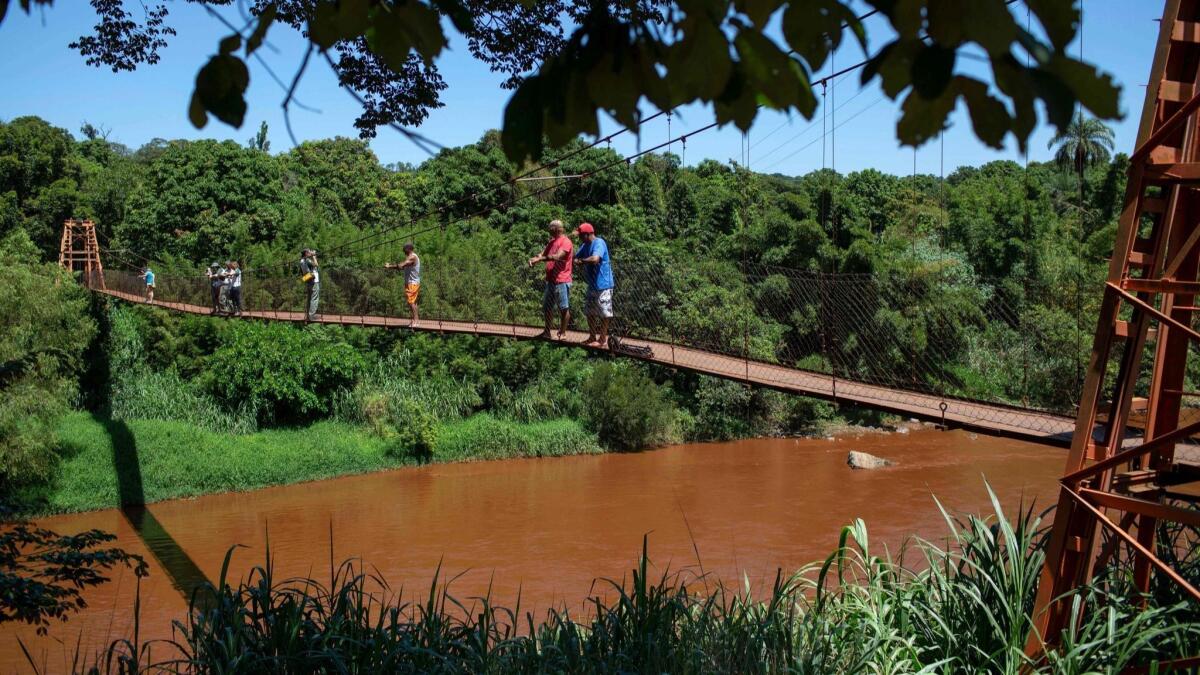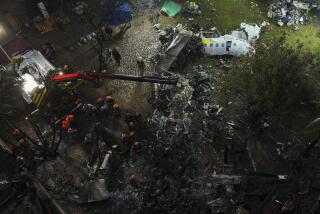After Brazil dam collapse, families search for loved ones using garden tools, their hands

- Share via
Reporting from Brumadinho, Brazil — Under a scorching sun, Tereza Ferreira Nascimento on Wednesday dug through the mud with garden tools and her hands in search of her brother Paulo Giovane dos Santos, resigned to the reality that he was most likely dead six days after a Brazilian dam holding back mine waste collapsed.
As search-and-recovery efforts continued, authorities also worked to slow mud threatening to contaminate a waterway that provided drinking water to communities in five of the country’s 26 states. The reddish-brown mud, with high concentrations of iron oxide, was heading down a small river toward the much larger waterway.
Friday’s breach at the mine owned and operated by the Vale mining company led to a sea of mud that plastered several areas of the southeastern city of Brumadinho. To date, 84 people have been confirmed dead and 276 missing. On Tuesday, five people were arrested in the disaster, including employees of Vale.
“We have been here since Friday, taking turns between brothers, brothers-in-law, searching for the body so that we can at least give him a dignified burial,” said Nascimento, holding back tears. “So far it has been in vain.”
Nascimento’s sister-in-law, Sonia Monteiro, knelt down to smell the mud. Other smells, of dead animals, had thrown them off before, but this time they believed they were on the right track.
“We were sensing a smell here, more or less, so we are digging to see if we find him,” said Nascimento, 41.
In the distance, helicopters could be heard and firefighters worked several areas, in theory in search of survivors but more likely looking for bodies. No one had been rescued alive since Saturday.

Vagner Diniz, 60, was holding on to some hope Wednesday that some of his five missing family members were still alive. His list of missing was staggering and included his two adult children and his daughter-in-law, who was five months pregnant.
“This was a massive assassination,” said Diniz, a resident of Australia who had come to his native Brazil on vacation.
He and his wife had come to see their children, find out the gender of their expected grandchild and visit Inhotim, a world-renowned art museum about a 15-minute drive from Brumadinho.
“It was going to be a fantastic week,” said Diniz, visibly exhausted from long days trying to get information on his family.
Diniz believes that when the dam collapsed Friday the family was in the Pousada Nova Estancia, an inn that got buried. On Tuesday night, he learned that his son’s body had been recovered.
It could be several days or weeks before many bodies are found, as the mud extends several yards deep. Firefighters have to be careful so as not to become trapped themselves.
The release of the muddy waste has already turned the normally greenish water of the Paraopeba River brown about 10 miles downstream from the southeastern city of Brumadhinho, site of the broken dam.
The Paraopeba flows into the much larger Sao Francisco River, which provides drinking and irrigation water to hundreds of municipalities and larger cities such as Petrolina, in the state of Pernambuco, 870 miles from Brumadhino.
Authorities are focused on the Retiro Baixo hydroelectric dam and plant complex about 185 miles from Brumadinho. Officials and environmentalists hope the dam’s reservoirs can be used to isolate the muck so it can be cleaned before that water is released and travels farther downstream to the Sao Francisco River.
Technicians for Furnas, the company that operates the dam, have concluded the waste poses no structural risk to the dam, the company said in a statement.
The muddy water and waste, moving just over half a mile per hour, was expected to reach the dam between Feb. 5 and 10, according to the Geological Survey of Brazil. The survey said the waste was destroying vegetation and aquatic life.
In the Pataxco indigenous village, dead fish and refuse such as plastic sandals were visible along the Paraopeba River’s banks.
“We used the river to take baths, to fish, to water our plants and now we can’t do any of that,” said the village’s chief.
Vale said in a statement it planned to install a fabric barrier to retain residues where the river reached the city of Para de Minas, about 25 miles from Brumadinho. The company may also build levees near the Brumadinho mine in an effort to prevent the sediment from moving.
Vale has been working to help victims, paying for funerals and announcing that people who’d lost family members would receive $27,000 in the form of a donation.
But for many victims, angry and anguished, all they want right now is to find missing loved ones.
Francisco Adalberto Silva has been searching for son Francis Erik Soares Silva and nephew Luiz Pablo Caetano since the disaster. The two worked for a company that contracted with Vale and were in the area of the collapse when it happened.
“I will keep coming,” he said. “I just want to give my son and nephew a dignified burial.”
More on Brazil: New president issues orders targeting ethnic minorities, LGBTQ community »

More to Read
Sign up for Essential California
The most important California stories and recommendations in your inbox every morning.
You may occasionally receive promotional content from the Los Angeles Times.













